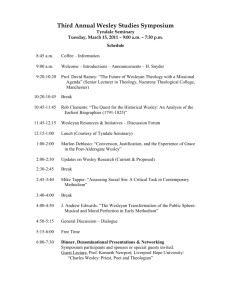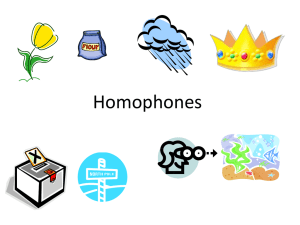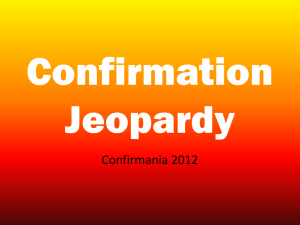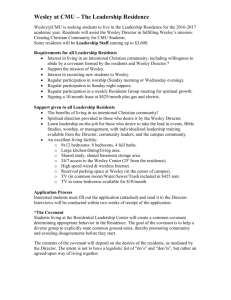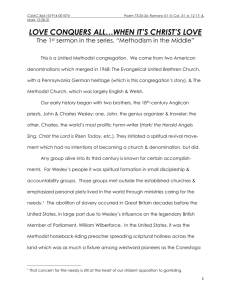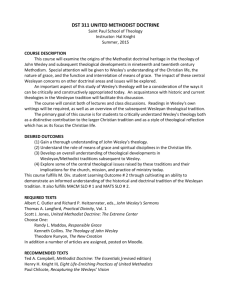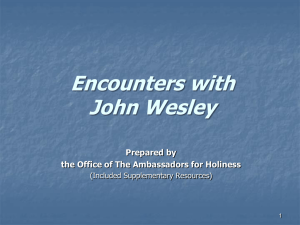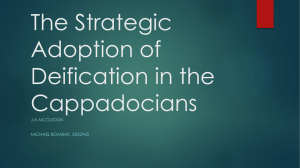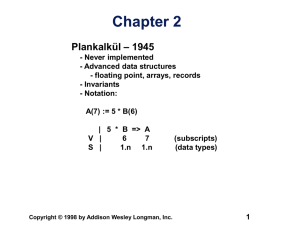Ozorovych Mykhailo – Presentation on John Wesley
advertisement
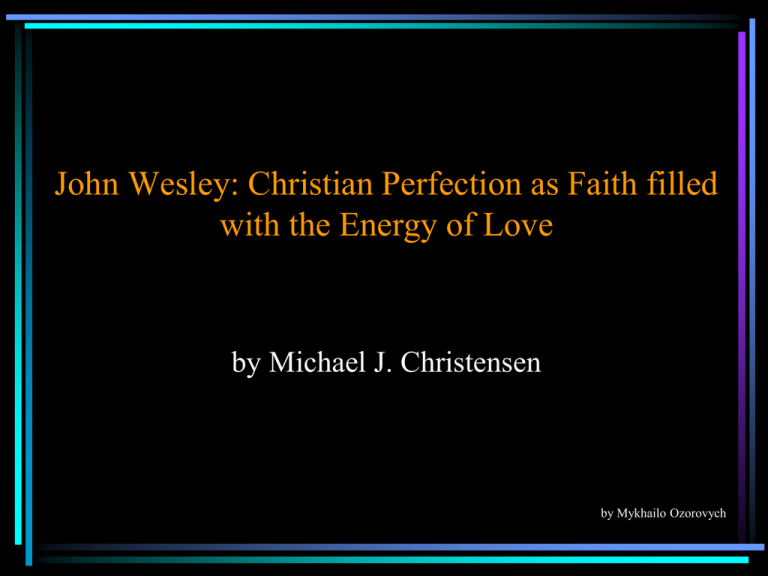
John Wesley: Christian Perfection as Faith filled with the Energy of Love by Michael J. Christensen by Mykhailo Ozorovych • Michael J. Christensen (M.A., Yale, Ph.D., Drew) is Director of the Shalom Initiative for Prophetic Leadership and Community Development, and Affiliate Associate Professor of Spirituality and Religious Studies at Drew University (Madison, New Jersey). • Dr. Christensen’s Ph.D. dissertation and expertise is on “Apocalyptic Interpretations of the 1986 Chernobyl Disaster.” • An ordained United Methodist minister. Married to Dr. Rebecca Laird. They have two teenage daughters. • John Wesley (1703–1791) was an Anglican cleric and Christian theologian. Wesley is largely credited, along with his brother Charles Wesley, as founding the Methodist movement. • Charles and his brother John did not always agree on questions relating to their beliefs. Charles Wesley is chiefly remembered for the many hymns he wrote. • “Eastern orthodoxy and Wesleyan theology are natural conversation partners because they drink from the same stream, and both are returning to the sources of their respective traditions”. • Author’s focus is on the question: to what extend does John Wesley’s doctrine of perfection or “entire sanctification” is influenced by Greek patristic conceptions theosis Theosis and Sanctification • Wesley drank from both wells (of classical theology and of Enlightenment rationalism) and appropriated a vision from the East (Clement, Origen, Macarius, Ephrem) and reformed it in the West in the programmatic interest of what seemed practically attainable “by grace through faith” in this life. • Subsequently, a distinctive Wesleyan spirituality characterized as “faith filled with the energy of love” emerged in the early Methodist movement in continuity with the older patristic tradition of deification • Entire sanctification (holiness, perfection) in the Wesleyan tradition refers to doctrine of spiritual trasformation and Christian perfection, which is available by grace through faith in this life. • It is understood by many Wesleyan theologians as a religious experience and transformation occurring subsequent to justification, with the effect that: 1. Holy Spirit takes full possession of the spirit, 2. cleanses the soul, 3. sanctifies the heart, 4. and empowers the will so that one can love God and others perfectly and blamelessly in this life • The holiness of God (along with other divine attributes) is believed to be actually imparted and not just imputed to the believer's life on the basis of what Christ accomplished on the cross. • The power of sin in one’s life is rendered inoperative as one participates in the higher life of the divine. John Wesley’s reformulation of a Patristic Doctrine • Albert Outler first alerted Wesleyan scholars to the influence of the Greek Church Fathers on Wesley especially by the Spiritual Homilies attributed to Macarius of Egypt but actually written by a fifth century Syrian monk under the influence of Gregory of Nyssa. • “Classical Methodist doctrine of entire sanctification is probably Wesley’s adaptation of the Patristic doctrine of theosis” - Charles Ashanin. • It “has significant parallels with the Eastern Orthodox theme of deification (theosis)” – Randy Maddox • According to Ted Campbell Wesley’s use of patristic sources was “programmatic” – he revised and edited his sources rather that preserved their original meaning, and did so with a pastoral motivation and agenda of church reform. Wesley’s reformulation of Clement of Alexandria Clement of Alexandria John Wesley Ascent of the soul to God is by means of On spiritual pilgrimage of human being toward the state of perfection the mystic powers of love can perfect the soul intent to cross over into the simple Divine life. faith and contemplative knowledge and wisdom (gnosis) • “John Wesley taught as Christian perfection, holiness, or entire sanctification is both historically derivative and dependent on the more ancient doctrines of deification…The 18th century had new problem to address theologically, and Wesley made an appropriate shift in doctrinal formulation. The affect of Wesley’s reconstruction of gnosis and theosis…was to make perfection in love more reasonable and more accessible in this life. By replacing the Platonic notion of assimilation and union (becoming god according to grace) with less esoteric and ambitious notion of imitation and communion (becoming like God by grace through faith), Wesley promoted a vision and a movement of “going on to perfection” • “…Wesleyan sanctification appears as a domesticated (or democratized) version of the more ancient doctrine.” Charles Wesley’s forgotten stand • For Charles perfection is when human beings are “changed from glory into glory” – an earlier model of patristic theosis. • The Wesley brothers disagreed about the nature, time, manner and extent of perfection in this life and the next. • Charles was speaking of theosis as a mystic, having poetic vision of a mystical union in which Christina soul is divinized and “lost in God”. He wrote “Change my nature into Thine”. • Because of the disagreements that the brothers had not all of Charles’ hymns that yearn for full redemption made it into John’s published collections. • According to John Tyson, John expected to go on to perfection in this life, Charles at the threshold death or in the next life. A postmodern Wesleyan agenda • “Wesley must be read in light of his sources – and therefore with larger ecumenical perspectives of historic Christianity” • Author finds “it fruitful to go behind and beyond John Wesley” and stand with him in his openness to new light of revelation within the tradition. • “Wesleyan theologians can then go back to Charles and beyond John (and back to Scriptures to exegete anew passages allegedly pointing to deification) in order to construct a more biblical, global, Wesleyan spirituality for the Third Millennium of Christendom”
